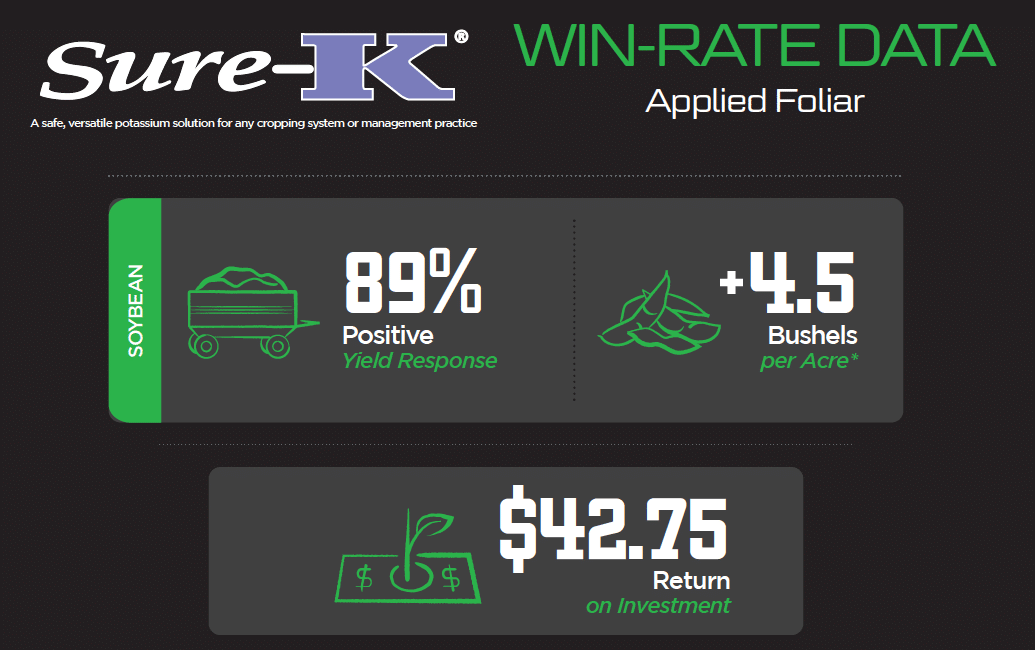Think you know a lot about growing soybeans? You probably do – in the U.S., soy is only second to corn in crop size. But there’s always room to grow more… and learn more. With this question and answer session, let’s look at the importance of soybean foliars.
What are foliars?
Foliars are nutrient solutions applied directly to the leaves of plants. Unlike traditional soil-applied fertilizers, foliars bypass root systems, delivering nutrients straight into the plant tissue for faster uptake.
How do they work?
Soybean leaves have tiny pores that absorb nutrients in solution. Foliar applications provide a readily available source of elements, particularly micronutrients like manganese, iron, and zinc, which can be less available in soil or made immobile by soil conditions.
How can AgroLiquid help?
AgroLiquid offers a range of foliar fertilizer solutions specifically designed for soybean quality. These products are formulated with high-quality, readily absorbable nutrients that can address specific deficiencies or support growth stages.
Have you heard about Nutriq technology by AgroLiquid? Nutriq ensures the availability of nutrients as well as the synergy between primary nutrients, secondary nutrients, and micronutrients. This approach, combined with the use of high-quality materials, is what makes peak performance possible.
What AgroLiquid products work well?
Sure-K: Sure-K is high-efficiency potassium fertilizer that gives soybeans the nutrients needed to thrive at reproductive stages. Sure-K uses no chlorides or hydroxides, so it has little risk of harming tissue and helps preserve soil health long-term.
LiberateCa: LiberateCa is liquid calcium sulfate fertilizer designed for easy application. Even though calcium is categorized as a secondary nutrient, it’s necessary for soybeans to reach their full potential. It’s good for building walls, resisting stress, increasing water transport, and forming healthy roots.
FertiRain: FertiRain is a complete multi-nutrient liquid fertilizer designed for better crop nutrition and growth. With macronutrients, secondary nutrients, and micronutrients all included in carefully measured amounts, FertiRain supports all soybean growth stages.
Can you prove they work?
Sure can. Researchers wanted to determine the effectiveness of the in-furrow and foliar crop nutrition programs on soybeans in eastern Great Plains soils.
In Aurora, Nebraska, researchers performed four treatments against a check:
Treatment 1: Check
Treatment 2: 1.5 gal/A ProGerm, 1.5 gal/A SureK
Treatment 3: Treatment 2 + 1qt/A LiberateCa
Treatment 4: Treatment 2 + Foliar – 1 gal/A FertiRain, 1 gal/A SureK
Treatment 5: Treatment 4 + Foliar – 1 qt/A LiberateCa

Following with 58.34 Bu/A was Treatment 4: Treatment 2 + Foliar – 1 gal/A FertiRain, 1 gal/A SureK, and even the application of Treatment 2: 1.5 gal/A ProGerm, 1.5 gal/A SureK was able to produce 1.56 more Bu/A.
In a second study, researchers evaluated the soybean response to application rates and timings of LiberateCa, which is a liquid fertilizer designed to prevent or correct calcium deficiency.
All treatments received PrimAgro P (1 gal/a) + Sure-K (1.75 gal/a) + Micro 500 (0.25 gal/a) + Boron (0.125 gal/a) in-furrow. Foliar treatments were applied at V4 or R1 soybean growth stage, and the calcium base saturation in trial area was 73%.

In addition, foliar applications at R1 growth stage provided better soybean yield response than applications at V4.
What about historically?
Great question. That’s just one of many studies AgroLiquid has performed. Of course, product performance consistency is as important as individual trial results.
Since 1998, AgroLiquid has evaluated yield response to foliar applied Sure-K at over 170 locations. These trials showed a high level of performance consistency and economic benefit. The economic response was calculated using the soybean market price and fertilizer costs appropriate for the year each trial was conducted.
From 184 trials, the calculations showed:
What if I wanted to hear it from someone else?
Check. Here, Kelly Garrett of XtremeAg.farm discusses that although he had a difficult season with drought and other issues, he saw improvements in soybean yield. In this trial, he tested with Sure-K and Kapitalize.
Where can I learn more?
We have numerous studies, articles, and resources available on our site – AgroLiquid.com. We also encourage you to reach out to any AgroLiquid representative to ask questions – we’re happy to answer them in an article or in person!


